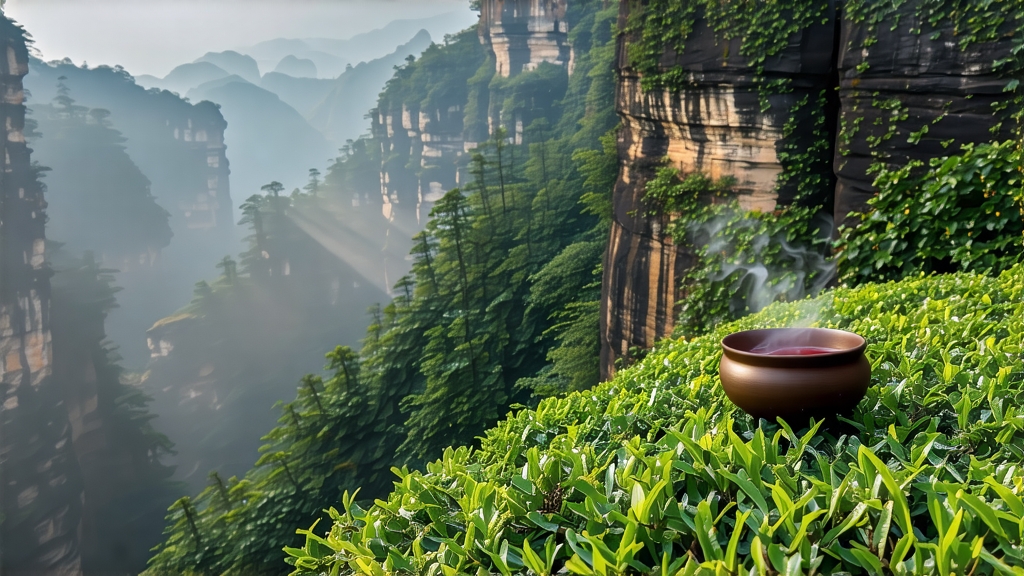
Wuyi Da Hong Pao—literally “Big Red Robe”—is the most mythologized oolong on earth. To Chinese tea lovers it is not simply a beverage; it is a liquid manuscript of Song-dynasty poetry, Ming-dynasty court intrigue, and modern auction records that eclipse the price of gold. Yet beyond the legend lies a living, breathing tea whose leaves still grow on 350-meter-high cliffs in northern Fujian’s Wuyi Mountains, drinking mineral mists and exhaling what locals call yan yun—“rock rhyme.” This essay invites the international reader to step past the red silk curtains of folklore and meet the tea itself: its genesis, its many faces, the alchemy that turns green leaf into aromatic charcoal, and the quiet ritual that coaxes from it a cup that tastes of stone fruit, orchid, and wet slate after summer rain.
Origin Stories: From Monks to Millionaires
The founding myth dates to the Ming era, when a scholar on his way to the imperial exams fell ill at the foot of Tianxin Cliff. Monks from the nearby Jiulongke Temple brewed leaves plucked from four scraggly bushes growing out of a cleft in the rock; the scholar revived, passed the exams, and returned in crimson official robes to drape the bushes in gratitude—hence the name. Whatever the truth, Qing-dynasty tax records already list “Yancha” (cliff tea) as tribute tea, carried on mule-back to Beijing in small locked chests. In 2002, 20 g of original-bush Da Hong Pao fetched 180,000 yuan at auction, catapulting the tea into global headlines and inspiring a wave of plantings throughout the Wuyi range. Today the genetic descendants of those mother bushes—protected by the state and no longer harvested—cover more than 4,000 hectares of narrow valleys and terraced cliffsides.
Terroir: Why Rocks Matter
The Wuyi Mountains are a 550-million-year-old rift valley where volcanic tuff has weathered into a mineral sponge. Rainwater percolates through the rock, emerging months later as sweet springs that irrigate tea roots with calcium, magnesium, and iron. Diurnal swings of 15 °C between fog-cooled dawns and sun-baked afternoons force the plant to thicken cell walls, concentrating aromatic precursors. The result is a pronounced “yan yun,” a tactile finish that feels like licking a wet stone then breathing out orchid perfume. No other oolong region—not even the nearby Anxi or Guangdong’s Phoenix Mountains—can replicate this lithic signature.
Cultivar Constellation: Original Bush, Que She, Bei Dou, Qi Dan
Purists speak of three bloodlines. “Original Bush” (母树) refers to the four living antiques still clinging to Tianxin Cliff; their leaf is illegal to pick. “Que She” (Sparrow Tongue) is a first-generation clone noted for small, sparrow-tongue-shaped leaves and a honeyed front palate. “Bei Dou” (North Star) is a 1960s agricultural institute selection prized for cold resistance and bright osmanthus notes. “Qi Dan” (Scarlet Robe) is the latest clonal release, bred for high cinnamic-linalool content that translates into a spicy, almost Bordeaux-like finish. Each cultivar is micro-roasted to a different charcoal profile, so a blind tasting can feel like comparing four siblings raised on separate continents.
Craft: The Eight-Armed Dance of Yancha Making
Plucking begins at dawn on the third or fourth day after the Grain Rain when the top leaf has just opened into the legendary “small open face.” Two leaves and a bud are snapped with a downward tug that bruises the stem just enough to start enzymatic oxidation while still on the bush. The leaves are then “yao qing”—shaken in 1.2-meter-diameter rattan trays for 8–12 minutes to crack cell walls and release grassy aldehydes. Oxidation proceeds in shaded corridors where 28 °C and 75 % humidity coax the leaf from green to a liver-brown rimmed with emerald center; timing is judged by the aroma shift from cut apple to ripe peach. A 230 °C tumble-roast for seven minutes kills the enzymes, followed by hand-rubbing to twist the leaf into the signature “dragonfly head, toad tail